Parasites
Not all disease causing organisms are microorganisms. Many larger parasitic organisms also cause disease. A parasite is an organism that lives in or on another organism (the host). The parasite gets some or all of its food from the host organism. This can cause anything from mild disease to death to the host. Parasites can also spread diseases from one organism to another.
Some parasites feed on the outside or the host organism. Others live inside the tissues and cells of the body.
Parasitic organisms which affect the health of people include fleas and headlice which live on the outside of the body and tapeworms which live inside the body.
Parasites have adaptations which help them avoid being removed by the host organism. For example, fleas can jump great distances so they avoid being crushed. Their mouthparts can cut open the skin and suck blood. Big infestations can cause anaemia through lack of blood and let other infections in. Fleas carried the bacteria which caused the plague.
Headlice crawl about the head hidden in the hair. They stick their eggs firmly to the hair while they develop. They bite through the skin and suck the blood.
Tapeworms spend part of their lifecycle in an animal such as a pig or a cow, or part of their lifecycle in a human being. They have special hooks and sucker on their heads so they can attach themselves to the wall of the gut. They are very thin and can grow very long. They absorb digested food from the gut through their body wall. It is when they find their way into the tissue of the brain or the lungs that they can cause serious disease.


Tapeworms are well adapted to survive in the human gut
Photos provided by CDC

















